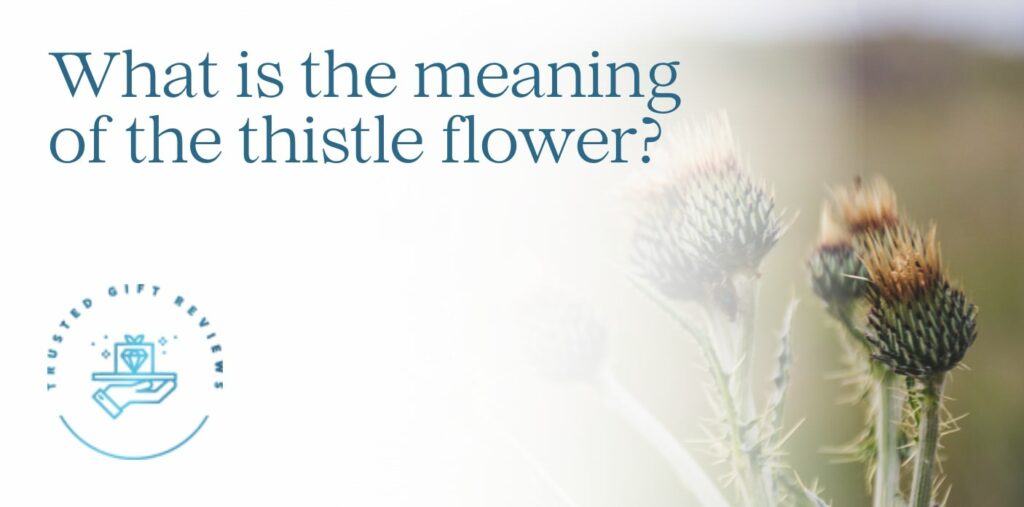Power and courage are the primary meanings of the thistle flower as suggested by its spiky leaves and blossoms.
Besides that, many Europeans consider them to be a symbol of luck and prosperity. The reason for this is their inherent ability to withstand drought and resist pests and diseases.
But it’s also worth noting that thistles have negative meanings, as they can hurt someone walking near it. So they connote accidents, disruption, and piercing words too.
Now, in this guide, we will further explore the thistle plant in terms of its botanical info, cultural importance, and uses and benefits.
Basic Information about the Thistle Flower


Genus: Cirsium, Carduus, Echinops, or Sonchus
Family: Asteraceae
Native Habitat: Europe and North America
Growth Behavior: Perennial, biennial, or annual
USDA Zone: 5 to 9
Thistle flowers are weed species belonging to many genera of the Asteraceae family. These genera are Carduus, Cirsium, Echinops, and Sonchus.
These prickly flowers come from and are widely grown in Europe and North America. They can be found in meadows, fields, and roadside areas receiving mild weather.
Gardeners usually grow them as lovely ornamentals and potted plants. Different than other plants, they give a unique texture and royal color to one’s abode or garden.
What does the Thistle look like?
Thistle plants are known for their spikes in the leaves, stems, and flowers themselves. They don’t have ray flowers like those of a daisy or sunflower, which they’re actually related to.
Most of these species have pink or purple flowers, but they have distinct appearances and growing locations.
For instance, the marsh thistle (Cirsium palustre) sports dark purple flowers and grows in boggy areas, and the bull thistle (Cirsium vulgare) is a vital plant that attracts pollinating insects in the UK but is treated as an invasive weed in several US states.
Some species of globe thistles (Echinops) are grown as fabulous ornamentals given their vibrant hues and ball-shaped beauty.
Whereas, the sow thistle (Sonchus) has leaves that are lightly serrated on the edges and is attractive to pigs, hence the name.
Etymology of the Word Thistle


Thistle was derived from a Germanic word that evolved into the Old English word thistel and the German or Dutch word distel. These words mean “to prick,” which accurately describes the plant’s form.
Another interesting etymological origin relating to thistles is that of Cirsium. Cirsium, one of the thistles’ genera, came from the Greek word kirso, meaning swollen veins.
Thistle was once believed to be a remedy for various vein problems including inflamed veins.
Thistle Flower Meaning and Symbolism


As discussed earlier, the thistle is associated with bravery, pride, dignity, and resilience owing to its defensive and hardy flower structure.
If we were to pick two flowers whose symbolisms work well together, they would have to be the gladiolus and thistle. The gladiolus can represent a sword, while the thistle, a shield in allusion to its spiny form.
Their symbolisms complement one another, with gladiolus meaning strength, victory, and pride and the thistle, endurance and courage. These are traits of a great warrior.
However, as thorns conjure unpleasant feelings (as in the saying “a thorn on our side”), thistle flowers also have negative meanings. They can signify problems, pain, heartbreak, disturbance, and discomfort.
Thistles and Their Cultural Significance


The thistle is regarded as a symbolic and important flower in certain countries, like Scotland and France.
In Scotland
The thistle is the national flower of Scotland. There, it is highly popular and cherished by its people.
That’s because it’s one of the key factors that led the Scots to win the war against the Norman invaders in the 15th century.
After a wave of bloody assault, a lot of Scottish soldiers were killed. Confident and ecstatic, the Normans planned a follow-up surprise attack to finish them off, but they had overlooked one thing: the abundance of thistles in their land.
Thereupon, one Norman soldier shouted in pain upon stepping on a thistle flower. The noise alerted the remaining Scots, enabling them to take action quickly and amazingly, turn the tide of battle in their favor.
In France
Apart from that, the thistle has been one of the most-liked flowers in France. Back then, the French believed that it protected them from wrongdoers and evil witches that cast dark magic spells.
The thistle was known as the “Herb of the Witches” or the “Flower of the Sun.” This stemmed from the belief that witches are afraid of light, but the thistle isn’t, as it grows in full sun.
And so, the flower is taken to symbolize the sun, which the witches are afraid of and try to avoid all the time. It’s then said to be a gift from heaven to protect people from all sorts of bad things happening.
Thistle in Art and Literature
A lot of wonderful poems and artworks featured the beautiful and prickly thistle plant in the early half of the 20th century.
Among the most notable ones are A Drunk Man Looks at the Thistle by Scottish poet Hugh MacDiarmid, Boards and Thistles by American photographer Ansel Adams, and Thistle featuring two extraordinary pink-red thistles painted by American painter John Singer Sergeant.
Thistle Meaning by Color


Thistles come in a range of colors, with the most popular ones being purple and pink. Other thistle colors are magenta, yellow, and white.
Each of these colors lends a certain positive meaning to the thistle flower. So here are what they mean:
Purple
Purple is a sublime color that represents royalty, wisdom, ambition, and luxury. It also means peace, pride, and freedom given its cool and somewhat strong shade.
In a way, purple dampens a bit the negative connotations that come with this flower because of the above-mentioned meanings.
Pink
A more fun, brighter color, pink is another of the most common hues that thistles come in. It expresses love, affection, and femininity.
The color is very pleasing and relaxing, and pink thistles will certainly stand out among your prized garden flowers.
Magenta
Magenta is a blend of romantic and passionate red and quiet, respectful violet. Combining these two gives it the great attributes of bliss, cheerfulness, and appreciation.
If you can’t decide between purple and pink thistles, then you should definitely go for magenta!
Yellow
Yellow is like a ray of sunshine. It’s a beautiful, bright, and cheery color that never fails to make someone’s day.
Yellow thistles are harder to find than purple and pink ones, but with any luck, you can find one from your local florist or nursery.
White
Even though white thistle blossoms still have spikes, they’re quite majestic to see. It stands for elegance, purity, innocence, and steadfast love.
White thistles can wonderfully match any color of bouquet, vase, or garden. They also show how you truly miss or care for someone you love.
Medicinal and Food Uses of Thistle Flowers


Certain thistle species are used to flavor food and treat various medical conditions. Allow us to explain them below to you:
Thistle in Medicine
Medicinally, the whole plant is used including the flowers and roots. Since the Middle Ages, it has been used to treat minor health conditions from canker sores to jaw pain to vertigo.
The melancholy thistle (Cirsium heterophyllum) had been once used as a potion to treat depression. However, further studies need to be done to validate if it indeed remedies the said mental illness.
According to research, Cirsium vulgare and Cirsium ehrenbergii thistles have been shown to possibly benefit people suffering from liver damage.
Thistle in Food
Going now to its food uses, parts of the plant are often used in salads, soups, and vegetable side dishes. Speaking of which, thistle seeds can be roasted and eaten, and the same goes for the roots, but they have to be dried and stored first.
Suitable Thistle Gifting Occasions


As a gift, thistle flowers are suitable to be given to one who has stayed strong and brave. It can be someone who has successfully dealt with a problem, recovered from an illness, or always supported you like a close friend or family member.
Thistle is an unusual and rare flower, and many florists don’t sell them. And so it may be a pleasant surprise to your recipient or guests if you use it to decorate special events and celebrations.
It’s good to mix thistles with other flowers such as roses and lavenders. This can make for a unique, festive, and terrific gift for a special person without being too “prickly.”
FAQS about the Thistle Flower


- What does the thistle mean spiritually?
Thistle is like a good luck charm that protects from bad luck and witchcraft. Apart from that, it has also been associated with Mother Mary due to its sap resembling a mother’s milk.
- Is the thistle flower toxic?
The thistle flower is not toxic to people or animals like cats and dogs. In fact, the entire plant is edible and safe to be eaten when prepared the right way.
And despite its thorny flowers, bees and butterflies like to come near this plant to feed on nectar and get pollen for another plant to bear seeds.
- Is it hard to care for the thistle flower?
Thistle flowers are one of the most beginner-friendly plants available. Once you have planted them, they become drought-tolerant and have good resistance to pests and diseases.
Still, that doesn’t mean you shouldn’t care for them properly. Proper care is needed for your thistle plant to flourish.
For this, you must give it well-draining soil, locate it in a place where it receives full sun, and water it regularly.




